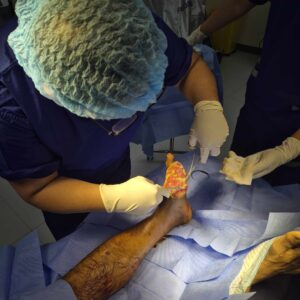Hips are among the most vital joints in the human body, responsible for bearing weight, supporting balance, and enabling motion such as walking, sitting, and climbing stairs. Healthy hips allow a person to move freely, maintain posture, and stay active without discomfort. When hips function properly, everyday tasks feel effortless, and mobility contributes greatly to confidence and overall wellness.
However, when hips become painful or stiff, life can change drastically. The hips are prone to wear and tear over time, particularly among individuals who are aging, overweight, or engage in physically demanding work. Conditions such as osteoarthritis, rheumatoid arthritis, fractures, and congenital deformities can lead to pain, inflammation, and limited range of motion. This discomfort often extends to the lower back, knees, or legs, making simple movements challenging.
Maintaining hip health is not just about comfort—it is essential for long-term independence. People who ignore persistent hip pain risk progressive joint deterioration, which can eventually require more complex interventions. Understanding how hips function and how to care for them is the first step toward staying mobile and pain-free.
When Hip Pain Demands More Than Rest
Hips that ache constantly or restrict daily activities should not be ignored. Occasional soreness after physical activity can be normal, but persistent stiffness, pain during rest, or difficulty walking can signal deeper issues. Many individuals delay seeking medical attention for their hips, assuming the pain will fade. Unfortunately, untreated hip problems often worsen over time, leading to severe degeneration that affects both mobility and quality of life.
When hips begin to interfere with sleep, work, or exercise, it may indicate conditions such as advanced arthritis or cartilage damage. These issues cannot be resolved through rest alone. Some patients experience grinding sensations or hear clicking noises when they move their hips, both signs of potential joint instability. Consulting a qualified orthopedic specialist helps identify whether conservative treatments like physical therapy or injections are enough, or if surgery might be the best option.
Ignoring pain can lead to more serious complications, including joint deformity and muscle weakness. Early diagnosis and treatment of hip conditions make a significant difference in long-term outcomes. Modern orthopedic care now offers advanced solutions to restore healthy hips efficiently and safely.
Advanced Hip Restoration and Replacement Solutions
Advancements in orthopedic technology have transformed how hips are restored and replaced. Modern hip restoration procedures are designed to relieve pain, restore motion, and allow patients to return to their favorite activities faster than ever. Whether caused by injury, arthritis, or joint deformity, damaged hips can now be treated using minimally invasive surgical techniques that prioritize precision and faster recovery.
One of the most effective innovations in hip replacement is the Direct Anterior Approach (DAA). Unlike traditional methods that require cutting through major muscles, this approach allows surgeons to access the hip joint from the front, minimizing trauma to surrounding tissues. As a result, patients experience less pain, faster rehabilitation, and reduced risk of dislocation. DAA has become a preferred method for restoring hips because it promotes quicker mobility and helps patients regain independence sooner.
Minimally invasive hip replacement also means smaller incisions and less blood loss during surgery. Many patients are able to walk within a day or two after the operation, with noticeable improvements in pain and function within weeks. Modern implants are designed to mimic the natural movement of hips, providing stability and long-lasting performance. These advancements have allowed thousands of individuals to return to normal life without the constant reminder of joint pain.
Why Patients Choose the Philippines for Hip Replacement
For many international patients, hips in need of surgery present not only a physical challenge but also a financial one. The cost of hip replacement in countries like the USA, UK, Australia, and New Zealand can be overwhelming, especially for those without comprehensive health insurance. Lengthy hospital waiting lists and high medical expenses often delay treatment, forcing patients to live in pain longer than necessary.
The Philippines has become a trusted global destination for hip replacement because it combines advanced orthopedic expertise with affordability. Hospitals are equipped with modern technology, and surgeons are internationally trained in the latest hip restoration techniques. Patients can expect the same quality of care they would receive in Western countries but at a fraction of the cost.
Beyond affordability, the country offers a compassionate approach to healthcare. Every stage of the patient experience—from consultation to rehabilitation—is guided by attentive medical teams who understand the unique needs of international visitors. Recovery in the Philippines often feels more personal and less stressful, supported by modern facilities and a culture known for hospitality and warmth.
Choosing the Philippines for hip replacement allows patients to access world-class orthopedic care without the burden of excessive costs or long delays. It represents a new path to mobility, freedom, and peace of mind for those seeking relief from chronic hip pain.
The Patient Journey: From Consultation to Full Recovery
The path to restored hips begins with an accurate diagnosis and an open discussion between the patient and the orthopedic team. The process typically starts with a virtual consultation, especially for international patients planning their procedure abroad. During this stage, medical history, imaging results, and symptoms are reviewed to determine whether hip replacement or another treatment is best suited for the condition.
Once the decision is made, patients receive a personalized treatment plan tailored to their medical and lifestyle needs. Surgery is performed in accredited hospitals equipped with the latest orthopedic technology. Throughout the procedure, safety and precision are prioritized to ensure the best possible outcome.
After surgery, patients undergo rehabilitation focused on restoring strength and mobility. Physical therapists guide exercises that help the hips regain balance, stability, and flexibility. Postoperative care includes pain management, wound monitoring, and gradual return to daily activities. Many patients report walking without major assistance within weeks and resuming normal routines within months.
The patient journey does not end at discharge. Continuous follow-up ensures that the hips remain strong and functional for years to come. Ongoing support from orthopedic specialists gives patients the confidence to move freely and live actively once again.
Restoring Freedom Through Innovation and Compassion
Hips are more than just joints—they represent movement, freedom, and quality of life. When hips fail, it affects every part of daily living, from independence to emotional well-being. Restoring healthy hips means giving people back the ability to live without constant pain or limitations.
Modern orthopedic centers that specialize in hip restoration combine technical excellence with compassionate care. Beyond surgery, they focus on the entire healing experience—helping patients regain confidence, manage expectations, and celebrate every milestone of recovery. The combination of advanced surgical methods, expert rehabilitation, and patient-centered care allows hips to function naturally again.
Success stories from patients who once struggled with hip pain serve as inspiration for others still searching for relief. Each restored hip is a step toward renewed energy, joy, and an active lifestyle. Choosing advanced hip replacement is not just about fixing a joint—it’s about reclaiming the life that pain once stole.
Takeaway
Healthy hips are key to a life of movement, strength, and independence. For those struggling with pain or limited mobility, modern orthopedic solutions offer real hope. Through advanced hip replacement techniques, experienced surgeons, and compassionate patient care, freedom of movement can be restored. Choosing expert treatment for hips is more than a medical decision—it is a life-changing step toward comfort, activity, and renewed joy.
Frequently Asked Questions (FAQ)
1. How long does recovery take after hip replacement?
Recovery time varies from person to person, but many patients start walking within one or two days after surgery. Full recovery of hips usually takes between six to twelve weeks, depending on physical condition and adherence to therapy programs.
2. Is hip replacement safe for older adults?
Yes. Hip replacement is commonly performed on older adults and is considered safe when conducted by experienced orthopedic surgeons. Restoring hips in older patients significantly improves mobility and quality of life.
3. What are the risks or complications?
As with any surgery, risks may include infection, blood clots, or temporary stiffness. However, modern techniques such as the Direct Anterior Approach reduce these risks by minimizing muscle disruption and speeding up recovery.
4. Can both hips be replaced at once?
Yes, some patients undergo bilateral hip replacement when both hips are severely affected. The decision depends on overall health, bone condition, and the surgeon’s evaluation.
5. How much does hip replacement cost in the Philippines?
Hip replacement in the Philippines is considerably more affordable compared to Western countries. Costs depend on hospital selection, type of implant, and length of stay, but patients can expect world-class results at a fraction of international prices.
6. Will I need physical therapy after surgery?
Yes. Rehabilitation is vital for rebuilding strength and ensuring proper movement of hips. A structured physical therapy program supports healing and helps prevent complications.
7. How long will the artificial hips last?
Modern hip implants are designed to last 15 to 25 years or longer, depending on activity level and overall health. Proper care, regular check-ups, and maintaining a healthy weight can extend implant longevity.






